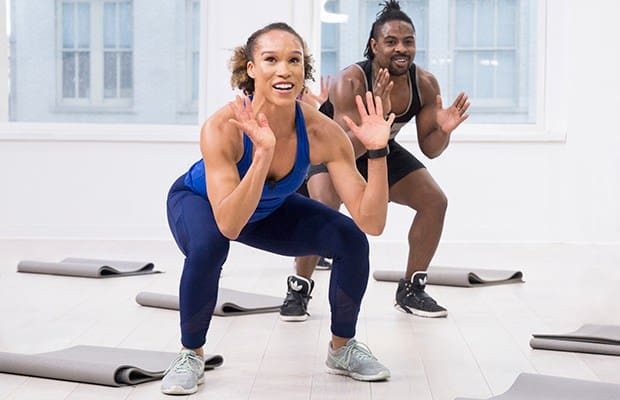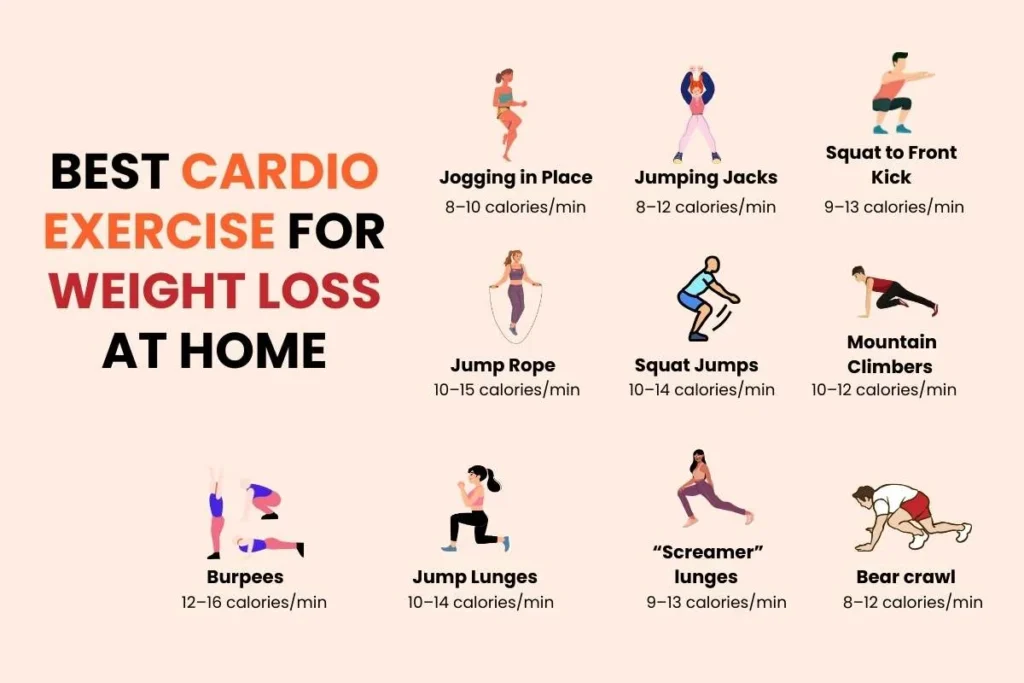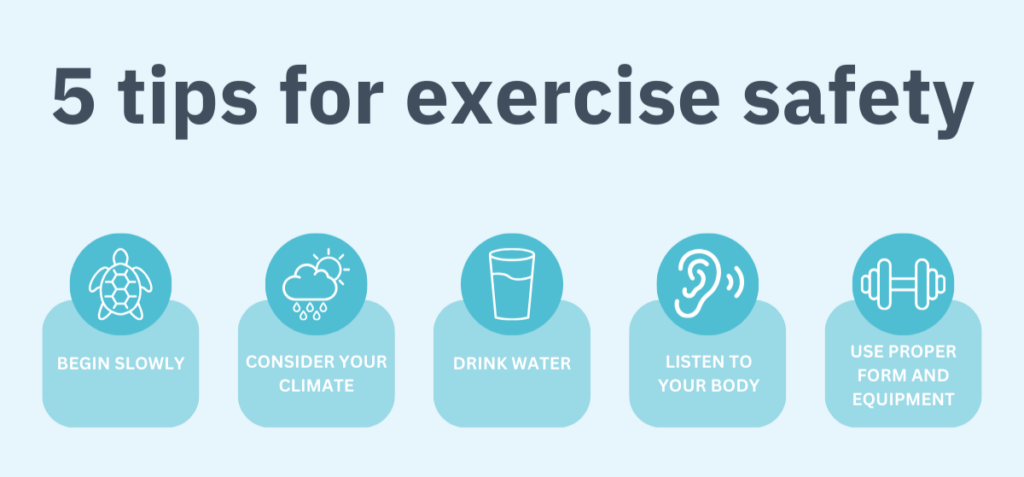
Home cardio workouts effectively strengthen your heart, improve circulation, and reduce the risk of heart disease. Consistent aerobic exercises like jumping jacks, burpees, and mountain climbers enhance heart efficiency, endurance, and stamina without requiring equipment. Balanced routines, proper warm-ups, and recovery support long-term cardiovascular fitness and overall well-being.
Key Takeaways
- Cardio improves heart efficiency, blood flow, and oxygen delivery.
- Aim for 150 minutes of moderate or 75 minutes of high-intensity cardio weekly.
- Include exercises like burpees, squats, lunges, and mountain climbers.
- Warm-up and cool-down prevent muscle strain and protect the heart.
- Nutrition, hydration, rest, and consistency boost results.
- Track heart rate and stamina to monitor progress.
- Prioritize safety, stop immediately if chest pain or dizziness occurs.
Introduction to Cardio Fitness and Heart Health
Cardiovascular fitness is the ability of your heart, lungs, and blood vessels to deliver oxygen-rich blood to your muscles during physical activity. A strong heart boosts endurance, lowers fatigue, and supports key body functions. Cardio workouts, or aerobic exercises, help strengthen the heart muscle, improve blood flow, and maintain overall heart health.
Understanding How Cardio Workouts Benefit Heart
Cardio exercises involve steady, rhythmic movements that raise your heart rate and breathing. This makes your heart work more efficiently, pumping blood with less effort over time. Beyond muscle strength, cardio improves blood vessel flexibility, lowers blood pressure, and balances cholesterol by reducing bad LDL and increasing good HDL.
It also reduces inflammation and cuts the risk of chronic illnesses like diabetes, stroke, and heart disease. Regular cardio keeps your heart strong and can add years to your life.
Key Principles for Effective Heart-Healthy Home Workouts
To protect and strengthen your heart, workouts must be consistent, varied, and suited to your fitness level. The goal is at least 150 minutes of moderate cardio or 75 minutes of high-intensity cardio each week, spread over several days. Moderate workouts raise your heart rate comfortably, while high-intensity bursts challenge the heart more. Combining both types keeps exercises interesting and effective.
Always start with warm-up exercises to prepare your heart and muscles, and finish with cool-down stretches to aid recovery and prevent dizziness. Creating a specific workout space at home helps form a steady exercise habit.
Top High-Impact Home Cardio Exercises for Heart Strength

Here are powerful bodyweight exercises that increase heart rate and promote cardiovascular strength. Perform each exercise for 30-60 seconds with 15-30 seconds rest, repeating circuits 3 to 5 times depending on your fitness level.
Marching in Place
Marching in place is an easy, low-impact warm-up that prepares your body for more intense exercise. Stand tall and lift your knees one at a time to waist height or as high as comfortable while swinging your arms naturally at your sides. This movement activates the major muscles of your legs and starts to increase your heart rate steadily without strain. It’s ideal for beginners or as a gentle way to transition into more vigorous cardio.
Jumping Jacks
Jumping jacks are a classic full-body cardio exercise that rapidly increases heart rate. Begin standing with feet together and arms at your sides. Jump while spreading your legs shoulder-width apart and raising your arms overhead. Jump again to return to the starting position. Keeping your movements smooth and controlled helps prevent joint stress and injury. Jumping jacks improve coordination, endurance, and involve arms, legs, and core muscles.
Squat Jumps
Squat jumps combine strength training with cardio for a powerful lower-body workout. Start by standing with feet shoulder-width apart, then bend your knees and hips into a squat position, keeping your back straight. From this squat, explode upward into a jump, extending your legs fully. Land softly by bending your knees to absorb the impact, then immediately move into the next squat jump. This exercise builds muscle power, boosts heart rate, and enhances leg strength and endurance.
Burpees
Burpees are a comprehensive, high-intensity exercise that targets multiple muscle groups and elevates cardiovascular fitness. The sequence involves starting in a standing position, dropping into a squat with hands on the floor, kicking your feet back into a plank position, performing a push-up, returning feet to squat, and then jumping up explosively with arms overhead. Burpees challenge strength, endurance, and cardio capacity, making them extremely effective for heart and overall fitness.
Mountain Climbers
Mountain climbers start in a plank position with your hands directly under your shoulders and your body forming a straight line. Rapidly alternate bringing your knees toward your chest as if running horizontally. This dynamic movement engages your core muscles heavily while also providing a cardiovascular boost. Mountain climbers improve agility, core stability, and overall heart rate conditioning.
Lunges and Screamers Lunges
To perform a lunge, step forward with one leg and lower your hips until both knees reach about 90 degrees, with the back knee hovering just above the floor. Push through the front heel to return to standing. “Screamers” lunges add a plyometric twist: after lunging, explode into the air and switch legs mid-jump so that the opposite leg comes forward for the next lunge. This variation increases the cardio intensity and builds explosive lower-body power.
Bear Crawls
Bear crawls involve moving forward on all fours with your hips raised and knees slightly off the ground. Place your hands and feet on the floor and crawl forward by moving the opposite hand and foot together, keeping your core engaged and hips steady. This full-body movement activates multiple muscle groups, increases heart rate, and improves strength and endurance, especially in the shoulders, arms, and core.
Boxing Punches
Boxing punches for cardio involve standing in an athletic stance with feet shoulder-width apart and throwing fast, controlled punches straight ahead. Alternate jabs, crosses, hooks, and uppercuts rhythmically to keep your heart rate elevated. This exercise strengthens the upper body, improves coordination and agility, and provides an effective cardiovascular workout without requiring heavy equipment.
Plank Jacks
In plank jacks, start in a high plank position with your hands under your shoulders and body in a straight line. Jump your feet apart wide, similar to a jumping jack motion, then jump them back together, all while maintaining a strong plank posture. This move combines core stability with cardio conditioning, engaging your abdominal muscles and increasing your heart rate.
Stair Climbing
Stair climbing is a simple but effective cardio workout you can do at home using stairs or a sturdy step platform. Quickly step up and down repeatedly, using your leg muscles to power the movement and keeping your core engaged. Stair climbing builds aerobic fitness, strengthens leg muscles, and boosts heart rate, making it a practical and accessible option for cardiovascular training.
Building a Comprehensive Weekly Cardiovascular Workout Plan at Home
A balanced heart fitness plan alternates exercise types and intensities. This prevents plateaus and reduces injury risk. Beginners can start with low to moderate intensity workouts 3 days a week, building up to more frequent, higher intensity sessions.
Sample beginner plan:
- Monday: Marching in place and jumping jacks circuits, 20 minutes
- Wednesday: Stair climbing and lunges, 25 minutes
- Friday: Bear crawls and boxing punches, 20 minutes
Intermediate plan:
- Monday: Burpees, mountain climbers, plank jacks circuit, 30 minutes
- Tuesday: Active recovery walk or gentle yoga
- Thursday: Squat jumps and screamers lunges, 30 minutes
- Saturday: Mixed cardio circuit (5 exercises), 40 minutes
Nutrition and Lifestyle Tips to Support Heart Fitness Alongside Home Workouts
Exercise is crucial for heart health, but it must be supported by proper nutrition and lifestyle choices to maximize benefits. Eating a balanced diet rich in nutrient-dense foods helps maintain cardiovascular function, while staying hydrated and managing stress further supports heart wellbeing. Adequate rest allows the body to recover, and avoiding excessive training prevents potential harm to the heart.
Key factors to support heart health alongside exercise include:
- Consume a diet high in fruits, vegetables, whole grains, lean proteins, and healthy fats
- Limit intake of processed foods, excess salt, and added sugars
- Stay well-hydrated by drinking enough water daily, especially before and after workouts
- Prioritize quality sleep to aid heart recovery and regulate stress hormones
- Manage chronic stress with techniques like deep breathing, mindfulness, or light stretching
- Avoid overtraining to prevent heart strain and weakened immunity
- Pay attention to your body’s signals and adjust workout intensity accordingly
Tracking Your Progress: How to Measure Improvements in Heart Health
Monitoring your heart rate is one of the simplest and most effective ways to track your cardiovascular fitness progress. By regularly checking your resting heart rate ideally first thing in the morning you can see improvements as a gradual decrease in beats per minute, which signals a stronger and more efficient heart. During exercise, staying within your target heart rate zones ensures that you work out at the right intensity to maximize heart health benefits without overexerting yourself. Many fitness trackers and apps now make it easy to monitor your heart rate in real time, providing instant feedback during your workouts.
- Check your resting heart rate daily for baseline improvements
- Use target heart rate zones during workouts to maintain proper exercise intensity
- Utilize fitness trackers or mobile apps for convenient real-time heart rate monitoring
- Look for signs such as increased stamina and endurance in daily activities
- Notice faster recovery times after exercise as fitness improves
- Pay attention to improvements in sleep quality linked to better heart health
- Consult a cardiologist before starting intense workouts if you have any heart conditions or concerns
Safety Tips and Precautions for Home Cardio Workouts

It is crucial to listen to your body during workouts to ensure safety and prevent injury. If you experience any warning signs such as chest pain, dizziness, severe shortness of breath, or irregular heartbeats (palpitations), stop exercising immediately and seek medical advice. Adapting exercises to suit your current fitness level and any health conditions is essential for effective and safe training. Begin with slower, gentler movements and gradually increase the intensity as your strength and endurance improve. Additionally, proper footwear provides support and reduces injury risk, and maintaining a clutter-free, safe workout environment helps prevent accidents.
- Stop exercising and seek medical attention if you feel chest pain, dizziness, shortness of breath, or palpitations
- Modify workouts to fit your fitness level and medical needs
- Start slowly and increase workout intensity progressively
- Wear appropriate, supportive footwear
- Keep your exercise area safe and free of obstacles
- Always warm up before and cool down after workouts to reduce stress on your heart and muscles
- Stay well hydrated to avoid cramps and fatigue
Conclusion
Cardiovascular fitness means your heart efficiently supplies oxygen to your body during exercise. Regular cardio workouts at home improve heart strength, circulation, and reduce disease risks. Aim for 150 minutes of moderate or 75 minutes of high-intensity cardio weekly. Warm-up and cool-down routines protect your heart and muscles.
Key at-home exercises include marching in place, jumping jacks, burpees, and lunges, all boosting your heart rate and endurance without equipment. Supporting your workouts with good nutrition, hydration, and rest enhances results. Track progress by monitoring your heart rate and stamina. Prioritize safety and consult a doctor for any heart concerns.
FAQs
1. What are the best cardio exercises for beginners at home?
Start with marching in place, jumping jacks, and stair climbing at a comfortable pace.
2. How often should I do cardio workouts for heart health?
Aim for at least 3 to 5 days per week with 30-60 minutes per session depending on intensity.
3. Can I build heart fitness without running or jumping?
Yes, low-impact exercises like marching, brisk walking, or stair climbing improve heart health safely.
4. Are short bursts of cardio better than longer workouts for the heart?
High-intensity interval training (HIIT) with short bursts is effective, but longer moderate sessions also provide benefits.
5. How do I avoid injury during high-intensity home cardio workouts?
Use proper form, warm up thoroughly, progress gradually, and listen to your body.
6. What is the ideal heart rate zone for improving cardiovascular health?
Generally, 50-85% of your maximum heart rate is effective, depending on fitness goals.
7. Can home workouts lower blood pressure and cholesterol?
Regular aerobic exercise positively impacts blood pressure and cholesterol levels.
8. Is it necessary to use equipment for effective cardio at home?
No, many effective cardio workouts require no equipment, using bodyweight movements.
9. How soon can I expect to see results in heart health?
Improvements can be noticeable within 4 to 8 weeks of consistent exercise.
10. What exercise modifications are recommended for people with heart conditions?
Consult a healthcare provider to tailor low-impact, controlled exercises avoiding overexertion.
Reference
- https://www.medicalnewstoday.com/articles/cardio-exercises-at-home
- https://utswmed.org/medblog/heart-cardio-workouts/
- https://www.bhf.org.uk/informationsupport/heart-matters-magazine/activity/exercises-heart-health
- https://www.harleystreet.sg/blog/best-cardio-exercises-for-heart-health/
- https://asianheartinstitute.org/blog/top-10-cardio-exercises-for-a-stronger-heart/
- https://artemiscardiac.com/blog/20-best-cardio-exercises-to-do-at-home
- https://www.endeavorhealth.org/articles/ways-your-heart-benefits-from-exercise
- https://www.heart.org/en/healthy-living/fitness/getting-active/10-minute-home-workout
- https://www.nike.com/in/a/cardio-workout-at-home
- https://calo.app/en/blog/cardio
Aubrey Carson is an RDN with 9 years across hospital, outpatient, and private practice settings. They earned an MS in Clinical Nutrition from Tufts University – Friedman School (2016) and completed a Dietetic Internship at Mayo Clinic. Aubrey specializes in micronutrient assessment, evidence-based supplementation, and patient education. Their work includes CE presentations for the Academy of Nutrition and Dietetics and collaborations with Mass General Brigham on nutrition education resources.

